What's better than cheese? Nothing, surely.
Actually, there is: open source cheese. And stop calling me Shirley.
Last saturday I finally cashed in on last year's birthday present, a one-day cheese making course at the William Angliss instutute of TAFE taught by Giorgio Linguanti of La Latteria fame. The course teaches how to make fresh mozzarella and a basic pecorino style cheese called primosale.
Over the course of the day, Giorgio explained that he thinks the australian cheese industry is quite closed and not many producers are happy to share ideas and recipes with each other. That's as opposed to the part of Italy he's from, where people are forever talking with each other about how to make better and more interesting cheeses.
So in the spirit of open source cheese, here is Giorgio's mozzarella recipe, which makes a delicious cheese.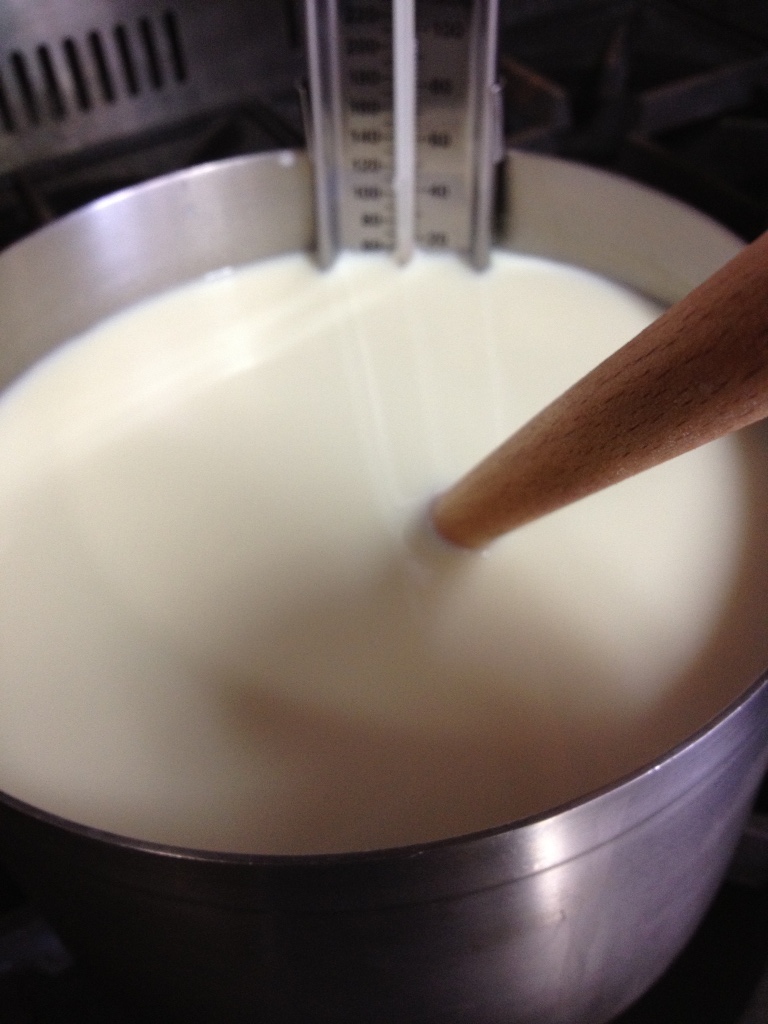 Use unhomogenised full cream milk for this recipe. It's not necessary to use raw milk, as (as Giorgio pointed out) the cheese won't be maturing at all, so there is no chance for the beneficial bacteria present in raw milk to influence the flavour at all. You need to use about 6 litres of milk for a kilo of mozzarella.
Use unhomogenised full cream milk for this recipe. It's not necessary to use raw milk, as (as Giorgio pointed out) the cheese won't be maturing at all, so there is no chance for the beneficial bacteria present in raw milk to influence the flavour at all. You need to use about 6 litres of milk for a kilo of mozzarella.
Per litre of milk, dissolve 1 to 1½ grams of citric acid into some cold water, then stir into the milk. This lowers acidity, which means we'll be able to stretch the curd later on. Don't add in too much, as you'll end up with soup!
Warm the milk to 37°C.
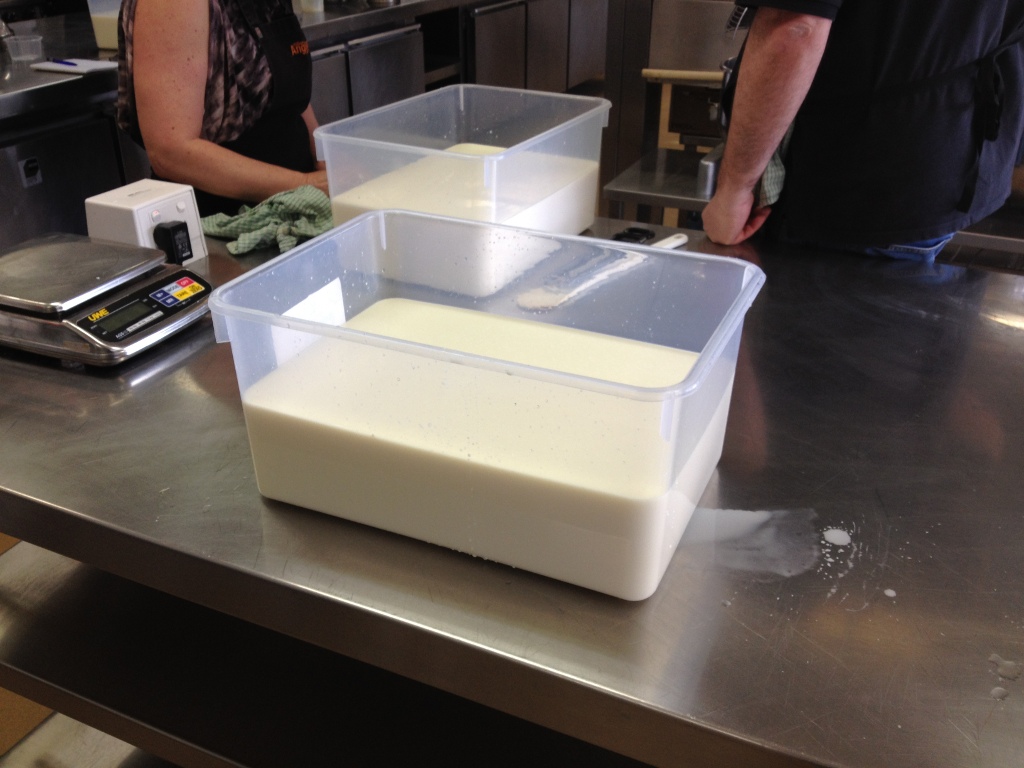 Pour the milk into a container that will let you easy cut the curd. A washed plastic storage container works fine.
Pour the milk into a container that will let you easy cut the curd. A washed plastic storage container works fine.
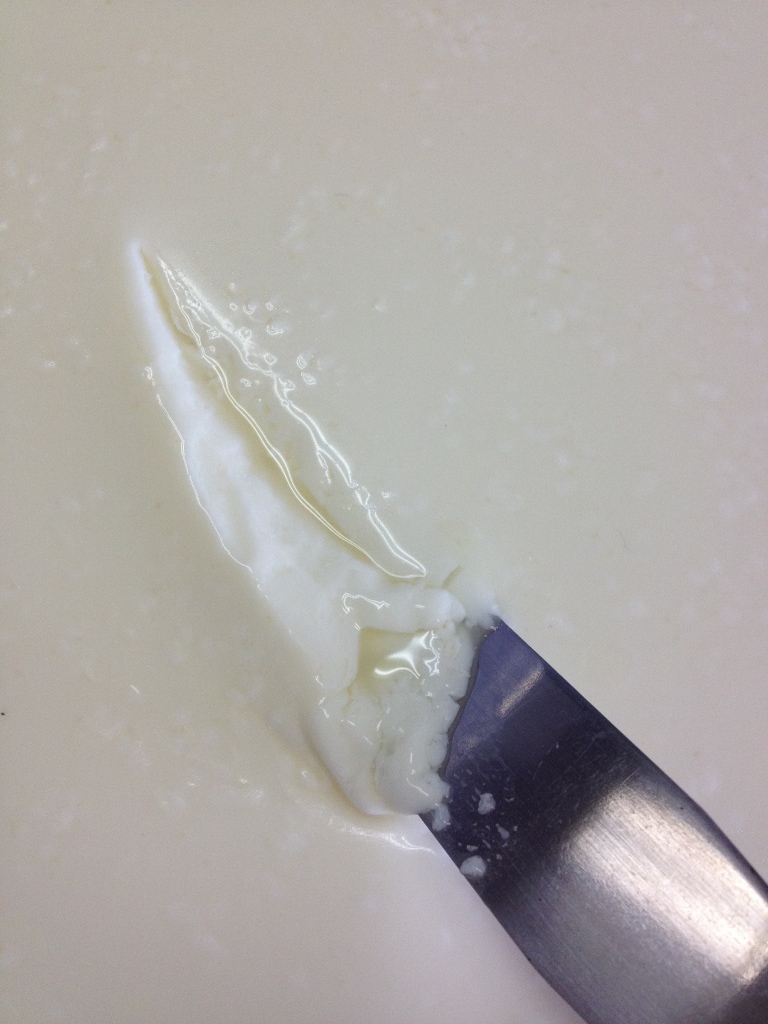 Add 0.2ml of rennet for each 1 litre of milk. Vegetable rennet is fine. Mix this in with your (cleanly washed!) hands for a few seconds, then use your hands to stop the milk from swirling any further. If it moves, the curds won't form properly.
Add 0.2ml of rennet for each 1 litre of milk. Vegetable rennet is fine. Mix this in with your (cleanly washed!) hands for a few seconds, then use your hands to stop the milk from swirling any further. If it moves, the curds won't form properly.
Go have a coffee and come back in 20 minutes.
Check that the curd has set. If whey runs into the cut when you lift the curds with a knife, you're good to go.
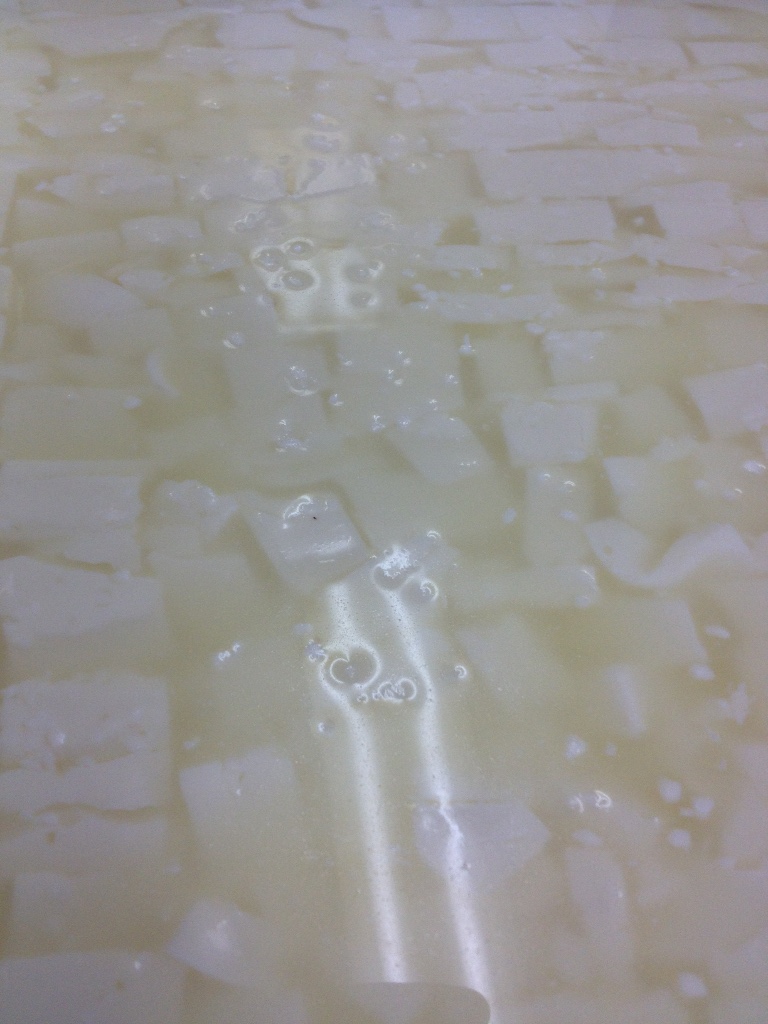
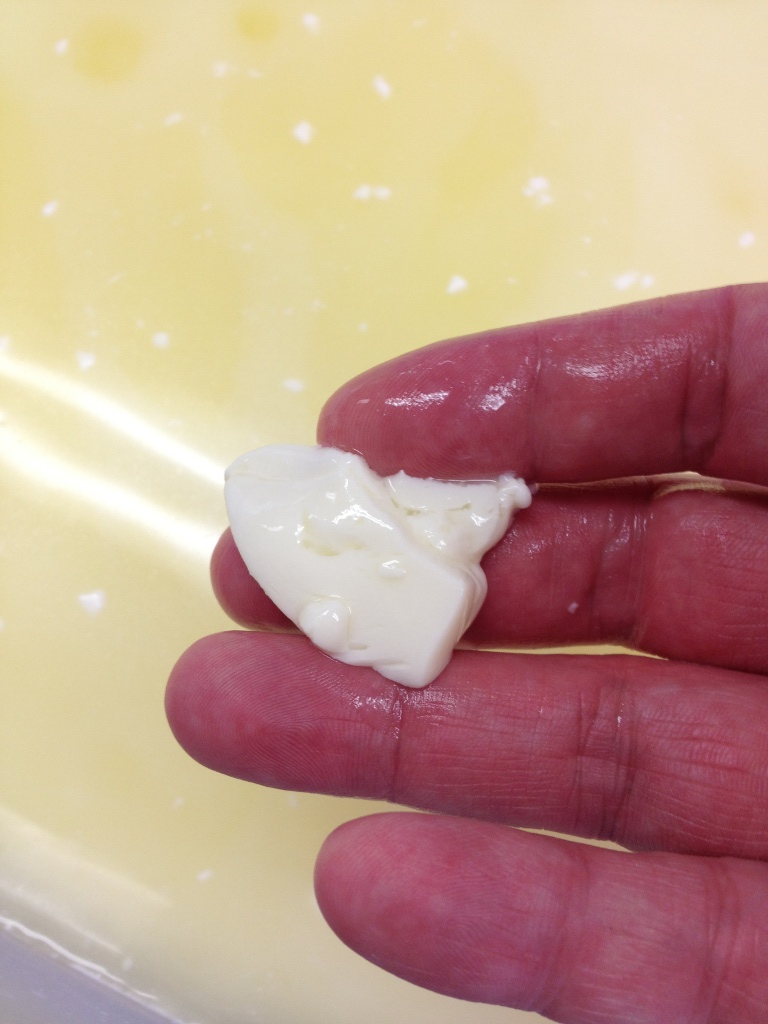 Cut the curds in a grid pattern, about 2cm wide. Then cut again with the knife at a 45° angle to the left and again at a 45° angle to the right.
Cut the curds in a grid pattern, about 2cm wide. Then cut again with the knife at a 45° angle to the left and again at a 45° angle to the right.
Go have another coffee and come back in half an hour.
Drain the whey from the container using a cup. You can use it to make ricotta, but you'll need a lot (about 25 litres of whey for 1kg of ricotta!) Use a colander to make sure you don't lose any of the chunks of curd.
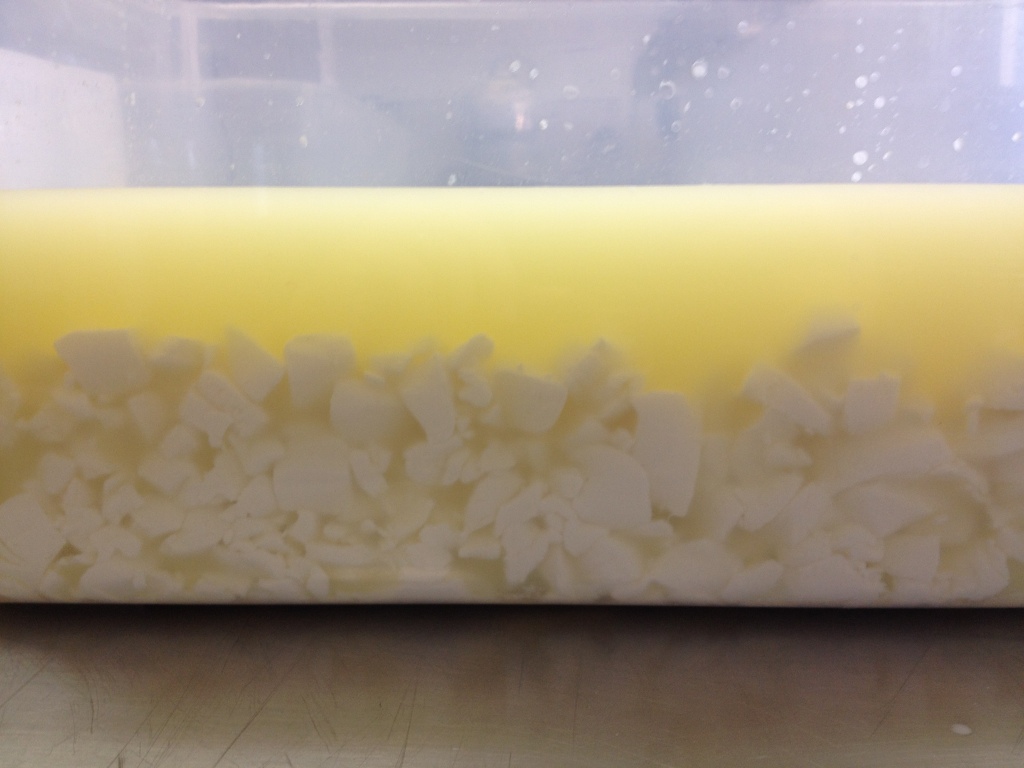 When you've gotten rid of most of the whey, put the curds in a colander and let them drain for a few minutes. As they drain, a skin forms that traps the whey, so cut the curds in the colander and turn them a few times, waiting a few minutes in between.
When you've gotten rid of most of the whey, put the curds in a colander and let them drain for a few minutes. As they drain, a skin forms that traps the whey, so cut the curds in the colander and turn them a few times, waiting a few minutes in between.
When the curds are mostly dry, it's time to stretch. You will need:
- two paddles or wooden spoons with long handles (or asbestos hands)
- a container of cold water to cool your hands and set the mozzarella,
- 2 to 3 litres of 85°C water
- a small handful of table salt (say 30-50g per kilo of curds)
- A bowl large enough to hold the curds, the hot water and your hands without overflowing or splashing
Put the curds in the bowl and mix through the salt.
Pour over the hot water (about 2 to 3 litres for a kilo of curds) to warm the curds.
As the curds melt, use the paddles or spoons to gather them into a single ball. Lift the ball out of the water and let it ooze back down, forming long strands. Repeat until your curds have the consistency of soft chewing gum but take care to not overwork them!
When you have the right consistency, chill your hands in the cold water before grabbing a chunk of hot curds. Hold your hands together (as if you were holding a dowsing rod) and use your fingertips to push the center of the curd up towards your face. At the same time, pull the top of the curd sideways with your tumbs, until you form a smooth, shiny surface.
 Form an O with the thumb and index finger of one hand and push the smooth surface of the curds through with the other hand. It will naturally start to form a ball. When the ball is the size you want, squeeze it off with the thumb and index finger, then drop it into the cold water.
Form an O with the thumb and index finger of one hand and push the smooth surface of the curds through with the other hand. It will naturally start to form a ball. When the ball is the size you want, squeeze it off with the thumb and index finger, then drop it into the cold water.
The larger the balls of mozzarella, the juicier they will be. You should probably aim for a diameter of around 5cm as a minimum size. Fresh mozzarellas made in Italy can weigh up to 2kg, so don't be afraid to make big ones! :-)
When you've used up all the curds, find the first mozzarella you made and eat it! Share the others with family and friends ... or not.
If you made a lot of mozzarella and find there is a lot of yellow fat floating on the water, you can pop the water in the fridge. That fat is butter and once it solidifies you can skim it off and use it.

And that's Giorgio's recipe. If you're game, the primosale recipe is on the right.
Me? I'm off to cheeselinks on the wekeend :-)


Add new comment